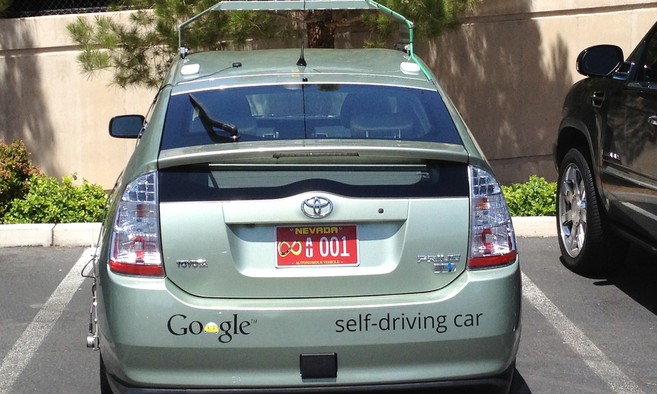
Anthropomorphisation is the attribution of human-like qualities to another thing. People often do this with robots, saying things like 'it wants to drive over there' or 'it saw me and turned around!'. When this happens naturally it can be a great indication of user friendly robot. But note that it happens when the robot is in the hands of end users. By contrast, anthropomorphisation of design happens at the beginning of a project. The concept crops up in design and engineering all too often in the guise of 'well this is how humans do X, so our system should emulate that'. In many cases, and especially so in robotics, this is a bad thing™.
Why? Because it limits the space of possibilities that the designers might consider, and worse, it leads to systems that fail to exploit their strengths and instead compete with the strengths of a completely different system.
As an example, someone commented recently on an IEEE Spectrum article about Google's autonomous vehicles: "No doubt it's a great step ahead in automation... but but but. Something is wrong.. because ... We [Drivers] has no computers in our heads, so we don't measure lengths, compute logarithms nor adding two numbers when we drive."
In all fairness, this commenter might not have been an engineer or designer, but this is backwards thinking. And on the Hacker News post about the same article, more people suggested that Google's team should focus on visual sensing, with such comments as "the technology is impressive, but humans drive okay without LIDAR, radar, or GPS." (Again to be fair, this commenter clarified his thoughts later, pointing out that he meant they should look at visual sensing as well.)
Fortunately, Sebastian Thrun and his team are designing an autonomous vehicle to drive at and beyond the abilities of a human. They are not designing an autonomous vehicle to mimic what a human would do. They realise that computers are incredibly good at computation over massive amounts of data, and pretty lousy at almost everything to do with vision. Humans are pretty slow at calculations, but our eye/brain combination is amazing at spotting patterns, detecting changes, and spotting moving objects in clutter. So Thrun's team plays to computers' strengths - they pre-scan the world ahead of time (incidentally this is a very smart move by Google - their competitors will struggle with the scale required to do this) and then have the two comparatively simple jobs of working out where their current sensor picture fits into that map, and what the differences are. They don't use visual SLAM, they use a particle filter and (as far as I can tell), ICP for scan matching - computationally intensive, but again, playing to their strengths.
This is just one example, but this kind of thinking turns up again and again. When we talk to customers about mobile robots in their homes, and mention that we have a very neat omni-directional wheeled platform, they often ask why we're not using legs to avoid the dreaded stairs problem. This is constrained thinking, led by anthropomorphic tendencies. Why are legs the first solution people think of? Why not flying robots? (don't laugh too hard - four out of the first fifty people we spoke with suggested this! Relax, we're not going there...) Why not a flexi-track like a packbot? Why not a stair lift? Why not just bank on robots being cheap enough to have one on each level?
Why? Because it limits the space of possibilities that the designers might consider, and worse, it leads to systems that fail to exploit their strengths and instead compete with the strengths of a completely different system.
As an example, someone commented recently on an IEEE Spectrum article about Google's autonomous vehicles: "No doubt it's a great step ahead in automation... but but but. Something is wrong.. because ... We [Drivers] has no computers in our heads, so we don't measure lengths, compute logarithms nor adding two numbers when we drive."
In all fairness, this commenter might not have been an engineer or designer, but this is backwards thinking. And on the Hacker News post about the same article, more people suggested that Google's team should focus on visual sensing, with such comments as "the technology is impressive, but humans drive okay without LIDAR, radar, or GPS." (Again to be fair, this commenter clarified his thoughts later, pointing out that he meant they should look at visual sensing as well.)
Fortunately, Sebastian Thrun and his team are designing an autonomous vehicle to drive at and beyond the abilities of a human. They are not designing an autonomous vehicle to mimic what a human would do. They realise that computers are incredibly good at computation over massive amounts of data, and pretty lousy at almost everything to do with vision. Humans are pretty slow at calculations, but our eye/brain combination is amazing at spotting patterns, detecting changes, and spotting moving objects in clutter. So Thrun's team plays to computers' strengths - they pre-scan the world ahead of time (incidentally this is a very smart move by Google - their competitors will struggle with the scale required to do this) and then have the two comparatively simple jobs of working out where their current sensor picture fits into that map, and what the differences are. They don't use visual SLAM, they use a particle filter and (as far as I can tell), ICP for scan matching - computationally intensive, but again, playing to their strengths.
This is just one example, but this kind of thinking turns up again and again. When we talk to customers about mobile robots in their homes, and mention that we have a very neat omni-directional wheeled platform, they often ask why we're not using legs to avoid the dreaded stairs problem. This is constrained thinking, led by anthropomorphic tendencies. Why are legs the first solution people think of? Why not flying robots? (don't laugh too hard - four out of the first fifty people we spoke with suggested this! Relax, we're not going there...) Why not a flexi-track like a packbot? Why not a stair lift? Why not just bank on robots being cheap enough to have one on each level?

Humans work well with legs, machines don't. Don't ignore wheels just because nature did.
And that's the take-away message from all this: play to your strengths. Don't emulate nature unless your system is well suited to doing so. Stop anthropomorphising design.
And that's the take-away message from all this: play to your strengths. Don't emulate nature unless your system is well suited to doing so. Stop anthropomorphising design.
 RSS Feed
RSS Feed